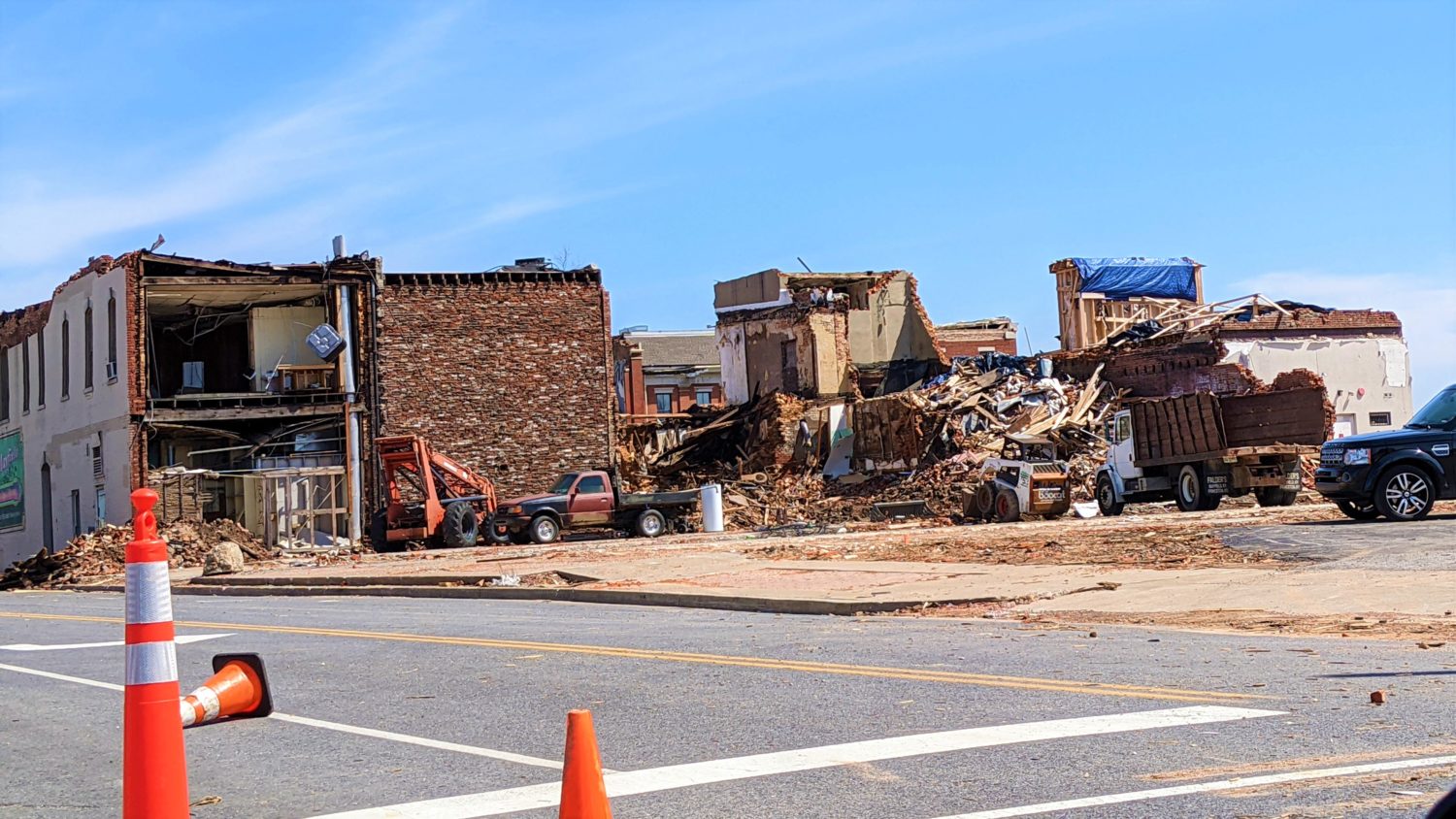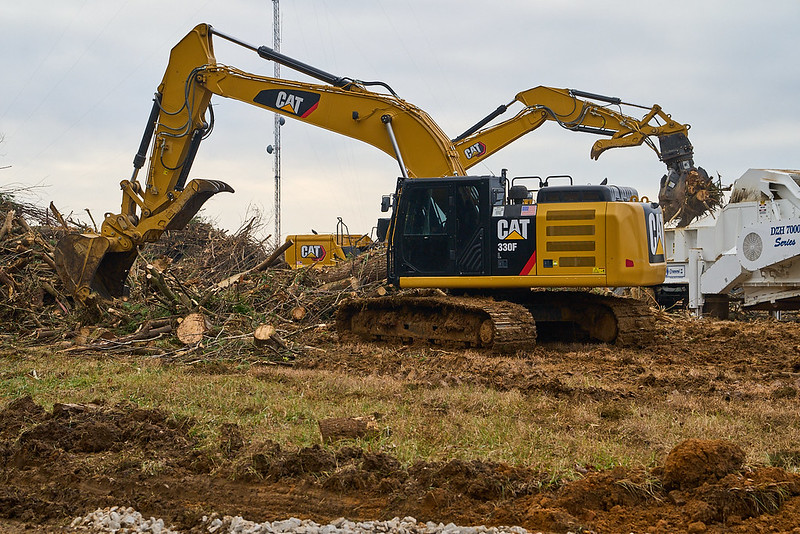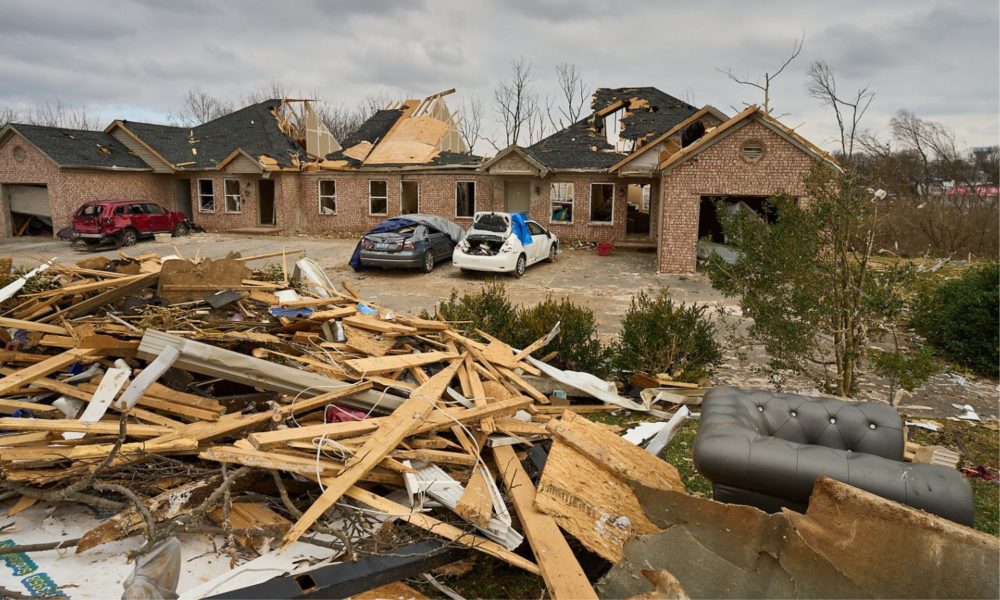Francisco Serrano’s parents lost their home in December. He recalls the moment when “dark, soulless skies spawned a demon-like tornado” in Bowling Green, Kentucky, that changed life as he knew it.
More than six months have gone by since record-breaking tornadoes tore through western Kentucky the evening of December 10th into the early morning of the 11th. When the sun rose that morning, the devastation across the region was tragically clear. People searched for loved ones, they mourned, they cried, they helped their neighbors. The nation witnessed the tragedy through news coverage and social media, and many donated money and provided immediate aid.
“As a people we will never be able to forget. We will always remember the people who lost loved ones, who were hurt, and the heroes who ran towards the cries for help,” Serrano said. “Heroes like my mom and dad. They are only alive due to nothing less of a miracle. They both stared down the eye of the storm and survived. Their first instinct— to help others. My mother recollects that it felt like she was back in the bloody Salvadorian civil war.”

The President of the United States even came to Kentucky to show his support for the survivors. After surveying the damage, he said, “Keep the faith. No one is walking away. We are in this for the long haul.”
Words without action
However, for Serrano, these words have not led to meaningful action. “Our community is gone. We no longer have a place to call home,” he says. “The politicians have all come and went leaving behind empty promises and photoshoots. ‘We’re saved.’, I sarcastically thought.”
Again, it’s been over six months, and Serrano paints the picture of life on-the-ground today:
“We are still dealing with the disastrous aftereffects of the tornado. Rubble remains on the sidewalk; bobcat excavators and large metal trash bins litter the community. Many of us still don’t have a place to call home.”

Pointing to the United Nations High Commissioner for Refugees’ definition of climate refugees as “persons displaced in the context of disasters and climate change,” he noted that the housing crisis was terrible before, but has worsened with the increase of local climate refugees.
Serrano’s experience could become increasingly common as tornado patterns shift further east and climate change exacerbates tornado conditions.
“Both temperature and moisture levels are expected to increase with climate change, the latter because a warmer atmosphere can essentially hold more water vapor,” my colleague Dr. Brenda Ekwurzel, Director of Climate Science at UCS, wrote in her blog post following the tornado outbreak. Evidence is accumulating that climate change contributes to conditions that provide more power to storms capable of producing tornadoes.
Advances in science and technology help predict tornado activity, so there is rightfully more focus (here, here, and here) on improving communication to residents so that they may seek shelter. Yet, even the best communications strategies won’t benefit those who are already struggling to find safe and adequate housing. With their homes destroyed, where will western Kentuckians go if they can’t afford to repair or rebuild or if there are no housing units available?
Crisis on top of a crisis
In 2018, the city of Bowling Green contracted Bowen Research to produce a housing needs assessment that found that the city’s poverty rate was well above state and national averages, with over 15,000 people and over one-fourth of all children in the city living in poverty. The following quote is from the assessment, and was brought to my attention by Laura Harper Knight, an organizer with Kentuckians for the Commonwealth (KFTC) to underscore the housing situation in Bowling Green. KFTC is a grassroots organization that works with its members across the state to achieve a better quality of life through a just energy transition, economic justice, housing justice, and voting rights.
“It is clear that many renter households are living in housing conditions that are considered to be below modern-day housing standards,” the assessment says, and that “the lack of available housing serving low-income households is likely contributing to the large number of renters living in substandard and/or cost burdened housing situations in the city.” The assessment identified the need for housing at all prices, with a high level of need for extremely low- and low-income rental housing and homes for purchase.
The city was already in dire need of safe and affordable housing for residents with low incomes. Now, with 500 homes destroyed in the county and many more damaged by the tornado, Bowling Green is in a full-scale housing crisis.
When help isn’t helpful
So what about FEMA (Federal Emergency Management Agency) and the government assistance promised by President Biden? Isn’t help available for those in need?
Well, the Kentucky Center for Investigative Reporting has found that most applications for assistance have been denied, as “…fewer than 14% of the 11,800 Kentuckians who asked for FEMA’s help within six weeks of the storm were approved for aid.”
Knight further explains the obstacles residents are facing: “Most existing systems of aid involve a lot of process and bureaucracy and are designed for short-term relief that drops off or are used up after a few weeks. Well-established national aid organizations are tied to bureaucratic structures that apply a standardized approach to disasters like this, which leave many impacted people falling through the gaps,” she said.
The documentation and inspections required for aid applications can be burdensome for those whose world just collapsed around them. What does a community do when most people who apply for aid are denied?
“Our community responded by developing our own systems of care so that we can show up for each other where the state and federal agencies are not able to, and this grassroots network of neighborly love is how we build the strength and resilience needed to withstand the future we’re headed towards. Mutual aid was what kept folks afloat amid this disaster and is what will continue to sustain impacted families,” Knight said.
The damage is much more than physical
Serrano and Knight both recognize the cascading impacts of a disaster–that the physical damage is only the beginning. Peoples’ entire lives are thrown off track.
“It can be said that the effects of natural disasters can be as or even more disastrous than war itself,” Serrano noted. “Access to mental health resources, free medical services, free housing, free food, clothes—all of these things are HUMAN RIGHTS. We’ll continue to fight for them, and for climate justice.”
“The impacts go far beyond replacing groceries and toiletries, and the availability of jobs, transportation, clean and affordable energy, and housing will continue to be an issue over the months and years to come,” Knight said.
“While Kentuckians show up for each other to demonstrate true community care, we need the long-term and structural changes of state systems to support us in building a better future. Money and donations passed between neighbors are not enough,” she added.
For Serrano, enough hasn’t been done: “Our cries for help may be ignored but we’ll continue to survive, and demand that our people are helped. Because just as Indigenous peoples have been warning us about our treatment of the planet, our earth’s health has deteriorated.”
How can we build resilience before the next disaster?
Times of crisis reveal the resilience of a community, or the lack thereof. And when a community is already contending with a housing crisis and poverty, the goal cannot be to simply bounce back to the way things were, because it already wasn’t working for everyone.
Truly resilient communities would have the infrastructure (including renewable energy infrastructure) and support in place to move from surviving to thriving. And, unfortunately for Bowling Green, KY, the compounding crises of inadequate housing and ongoing poverty made them even more vulnerable when disaster struck.
The time to build resilience is now, and Knight offers a vision for meaningful change that begins with staying together as a grassroots community to care for long-term needs. Using collective power, she sees people demanding their cities adopt disaster mitigation plans to ensure they’re not left vulnerable to the next disaster as they try to rebuild.
Knight calls for city planning that regulates in response to the shifting environment as the climate crisis intensifies and accounts for the resulting loss of homes and livelihoods.
“We need to build our infrastructure with extreme heat, tornadoes, and other extreme weather events in mind to help keep us safe. And most of all, we need to do everything we can to decrease our collective environmental impact at the city, county, and state-level,” she said.
Housing justice is climate justice
Lawmakers must recognize the interconnectedness of the challenges that come to light during emergency situations, and design holistic, community-informed policies to protect the health, well-being, and safety of all.
Our homes are where we seek shelter from storms, yet they are vulnerable to damage from tornadoes, flooding, and fires. Water damage in homes can lead to mold, which increases negative health risks to residents. It is expensive to power our homes on fossil fuels, which contribute to global warming and present adverse health risks from pollution.
Diana Hernández, PhD, sums it up perfectly in her paper Climate Justice Starts at Home: Building Resilient Housing to Reduce Disparate Impacts From Climate Change in Residential Settings: “Resilient housing can uphold the principles of climate justice by ensuring that all populations have a structurally and socially sound platform by which to withstand the impacts of climate change.”
Knight and her colleagues at KFTC see these issues as intricately connected and seek to build a Kentucky where all people can thrive. They advocate for a just energy transition, opportunities to invest in our commonwealth’s future, and, most importantly, invest in our people–so we can move from surviving to thriving, from poverty to prosperity, all while living in healthy, safe environments with clean air and water and dignified housing.
“Using hydroelectric, solar, and wind power would help keep Kentuckians’ electric bills lower when fossil fuel prices rise, and could create new job opportunities that support our families without harming our bodies and environment.” Knight says, “Tell the Public Service Commission to lower rates and invest in clean energy, and tell your legislators and demand a just transition to build a safer future for all.”
In the meantime, there’s a long road ahead for Serrano and those who are still hurting from December’s tornadoes.
“So, ‘are we okay?’, you ask,” Serrano said, “No, far from it. But we will be.”

Francisco Serrano is a Bowling Green native, a tornado survivor, and a fierce community organizer.

Laura Harper Knight is a Lead Organizer with Kentuckians For The Commonwealth and lives in Bowling Green, Kentucky. Her experience with housing issues in her community has been a driving force in her work for social change. She is a long time KFTC member, having served on the Steering Committee and Economic Justice Committee, and joined KFTC staff as an Organizer in 2017.
CORRECTION: An earlier version of this post incorrectly stated that Francisco Serrano lost his home in the Bowling Green tornado.

